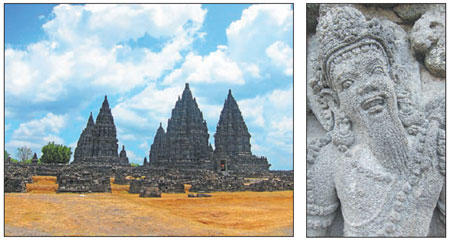Following in Rama's footsteps
Updated: 2013-01-06 08:40
By Erik Nilsson(China Daily)
|
|||||||
|
Left: The construction of Prambanan is believed to commemorate the shift from Mahayana Buddhism to Shivaist Hinduism. Right: The subject matter of bas-relief images on Prambanan derives from Hinduism. |
Candi Prambanan is the Hindu doppelganger of central Java's globally iconic Buddhist Borobudur stupa.
Indonesia's largest Hindu temple was constructed at the same time as Borobudur, in about the 9th century, and is also dedicated to preaching narrative through bas-relief images, although its plot derives from Hindu, rather than Buddhist, cosmology.
Consequently, its protagonist is Vishnu's avatar, Rama, rather than Siddhartha - the prince who became Buddha. And Prambanan's narrative is that of Trimurti, the triumvirate of Brahma, Vishnu and Shiva.
Like Borobudur, Prambanan also uses stone reliefs to tell moralistic stories to enlighten the faithful.
Its construction is believed to have been a commemoration of the shift from Mahayana Buddhism to Shivaist Hinduism, and its abandonment is said to have followed the relocation of the royal court after an eruption of Mount Merapi.
Temblors later crushed most of the towers, then foliage swallowed the ruins.
In 1811, a team sent by Britain's ruler of Java, Sir Thomas Stamford Raffles, "rediscovered" the holy site.
Earnest rebuilding began in the 1990s, which also reconstructed Prambanan's religious significance among local Hindus, who've since resumed staging religious ceremonies there.
However, the 2006 earthquake wrought new devastation, and most of the compound remains off limits because of safety concerns.
The ancient Ramayana ballet has been staged near the ruins every full moon since the 1960s, and open-air and indoor stages for more frequent shows have since been constructed in the temple's shadow.
This dance is based on Ramayana (Rama's Journey), an epic illustrated by the compound's bas-reliefs and statues. The legend about the abduction of Rama's wife is meant to show how to be the perfect ruler, the flawless father, the faithful wife, the loyal slave.
Prambanan's layout is a cosmological mirror of Borobudur's, with the terminology borrowing from Hinduism rather than Buddhism but the meanings and arrangements being virtually identical. Its arrangement also moves from carnal, lower and outer realms to become more enlightened, lofty and central as pilgrims spin upward and inward.
The complex was originally studded with 240 temples arranged in concentric squares, and, like Borobudur, the buildings become grander in physical and spiritual stature toward the center.
The compound itself is orbited by a constellation of more than a dozen smaller, tumbledown and mostly Buddhist temples.
Prambanan takes other monikers from the Rara Jonggrang Legend, in which demons were said to have constructed the nearby namesake temples.
The myth goes that Princess Rara Jonggrang resists the courtship of Prince Patih Gupolo, who usurped her father's throne by murdering him.
She finally agrees to marry him if he can complete the impossible task of constructing 1,000 temples in a single night. The prince summons demons, who set about this mission.
But as the final temple is being constructed, the princess and her maids ignite a blaze in the East and pound rice to trick the demons, who flee the sunrise they believed imminent.
The indignant prince turns her to stone and she becomes part of the compound, ultimately finishing the final temple and the terms of their betrothal.
But whatever you believe about the ancient sagas told about the temple, there's much to learn from its true history it has etched in time and the allegorical fables carved into it.
(China Daily 01/06/2013 page16)
